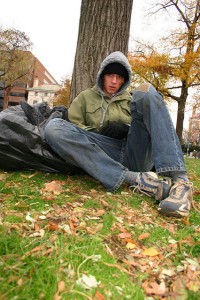By Bonnie Sestito

Used by permission http://www.creativecommons.org
Day after day, especially at certain times of the day, homelessness stares me in the face. When sitting in my car at an intersection near my home waiting for the light to turn green, men, women, and even teens hold up signs asking for money: “Homeless…Need $$$ for Food…God Bless You;” “Lost Home…Two Small Children…Anything Will Help;” “Homeless…Spare Any Change?”
How often do you encounter homeless people? Have you noticed that they seem to be getting younger? What is the first thing that comes to your mind when you see a homeless person? I used to ask myself “why,” because there are so many services available. But now I ask myself to wonder about their story, especially why there are more and more young people out on the streets. Because of my involvement with the youth initiative team of All Hands In, a non-profit 501c3 organization dedicated to raising awareness about human trafficking, it has helped me to have some understanding.
Every year two million kids in America will face a period of homelessness. Some are in a family unit and some are unaccompanied (no parent or guardian). So, what leads kids to this unaccompanied homeless way of life? A pregnant girl is rejected by her guardian, a kid is abused by an alcoholic parent, or is rejected because of her sexual orientation, or is trying to escape gang membership or a life of forced prostitution…. The main cause of homelessness among children and youth is physical, sexual, and/or emotional abuse from a parent or guardian.
Here are a few statistics* for you to ponder.
- 57% of homeless kids spend at least one day every month without food.
- In the United States, as many as 20,000 kids are forced into prostitution by human trafficking networks every year.
- 50% of adolescents aging out of foster care and juvenile justice systems will be homeless within six months because they are unprepared to live independently and have limited education and no social support.
- Almost 40% of homeless persons in the United States are under 18 years old.
These statistics are mind-boggling, but there is something we can all do to make a difference.
- According to DoSomething.org, surveyed runaway youth felt that one of the biggest barriers to getting help was a lack of knowledge about what services exist. Check out the DoSomething.org website. You can sign up and get facts on youth homelessness and hang ready-to-printer flyers with a hotline number in key places to help them find vital resources like counseling, shelter, and first aid. (https://www.dosomething.org/us/campaigns/flyer-away?source=node/775)
- Join the movement with Sleep Out America where, for one night, you can make a difference for homeless youth in your own backyard. Sleep Out is not about pretending to be homeless. It’s a demonstration to homeless young people that you care—deciding that you can’t stay indoors while so many kids remain outdoors. (https://sleepout.donordrive.com/index.cfm?fuseaction=cms.home)
- Become an advocate. Some legislative focuses are trafficking of minors, foster care reform, employment and education programs, transitional housing programs. (https://www.covenanthouse.org/childrens-charity/child-advocates)
Educate yourself. Advocate for others. And pray that God will open our collective eyes to the need to care for all of God’s children
*Covenant House website, https://www.covenanthouse.org/homeless-teen-issues/statistics
This post is related to American Baptist Women’s Ministries 2017-2018 mission focus on homelessness. For more information and resources, visit www.abwomensministries.org/missionfocus.
 Bonnie Sestito is president of American Baptist Women’s Ministries of Massachusetts.
Bonnie Sestito is president of American Baptist Women’s Ministries of Massachusetts.







